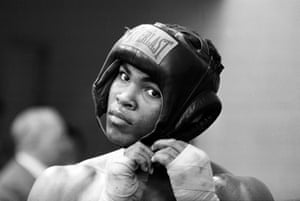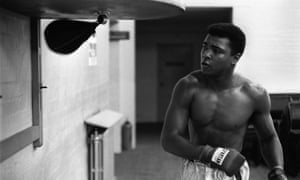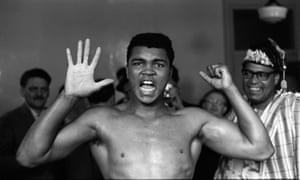Answer:
"There is always room for improvement."
How 1% Performance Improvements Led to Olympic Gold
Eben Harrell
OCTOBER 30, 2015

When Sir Dave Brailsford became head of British Cycling in 2002, the team had almost no record of success: British cycling had only won a single gold medal in its 76-year history. That quickly changed under Sir Dave’s leadership. At the 2008 Beijing Olympics, his squad won seven out of 10 gold medals available in track cycling, and they matched the achievement at the London Olympics four years later. Sir Dave now leads Britain’s first ever professional cycling team, which has won three of the last four Tour de France events.
Sir Dave, a former professional cycler who holds an MBA, applied a theory of marginal gains to cycling — he gambled that if the team broke down everything they could think of that goes into competing on a bike, and then improved each element by 1%, they would achieve a significant aggregated increase in performance.
I recently caught up with Sir Dave to learn more about his success in cycling and what lessons his experience holds for managers in other arenas. An edited version of our conversation follows.
HBR: Can you share some examples of your marginal gains approach?
Sir Dave: To give you a bit of background, when we first started out, the top of the Olympic podium seemed like a very long way away. Aiming for gold was too daunting. As an MBA, I had become fascinated with Kaizen and other process-improvement techniques. It struck me that we should think small, not big, and adopt a philosophy of continuous improvement through the aggregation of marginal gains. Forget about perfection; focus on progression, and compound the improvements.
By experimenting in a wind tunnel, we searched for small improvements to aerodynamics. By analyzing the mechanics area in the team truck, we discovered that dust was accumulating on the floor, undermining bike maintenance. So we painted the floor white, in order to spot any impurities. We hired a surgeon to teach our athletes about proper hand-washing so as to avoid illnesses during competition (we also decided not to shake any hands during the Olympics). We were precise about food preparation. We brought our own mattresses and pillows so our athletes could sleep in the same posture every night. We searched for small improvements everywhere and found countless opportunities. Taken together, we felt they gave us a competitive advantage.
HBR: What was the process for identifying these opportunities?
We had three pillars to our approach, which we called “the podium principles.” The first one was strategy. The second was human performance; we weren’t even thinking of cycling, but more about behavioral psychology and how to create an environment for optimum performance. The third principle was continuous improvement.
For strategy we analyzed the demand of each event and spent a lot of time trying to understand what it would take to win. So as just one example — what is the power needed off the line to get the start required to achieve a winning time, and how close is each athlete to being capable of generating that power? For this and other metrics, we looked at our best athletes and identified the gap between where they were and where they needed to be. And if it was a bridgeable gap we put a plan in place. But if it was not a bridgeable gap we had to be pretty ruthless — compassionate, but ruthless. Not all athletes are destined for the podium and we weren’t interested in fourth place.
And then we progressed with a brainstorm and tried to break down the optimal preparation for our athletes to eventually reach their peak. How would they need to train? What should their diet be, and so on. But the whole point about our approach is that it was meant to be continuous. We learned as we went.
Interestingly, when I moved from the track to the Tour de France, we didn’t get it right at all; our first few races were well below expectation. We took an honest look and realized that we had focused on the peas not the steak. We tried so hard with all the bells and whistles of marginal gains that our focus was too much on the periphery and not on the core. You have to identify the critical success factors and ensure they are in place, and then focus your improvements around them. That was a harsh lesson.
HBR: You’ve spoken elsewhere about how the success of marginal gains can be attributed to culture as much as anything else.
Perhaps the most powerful benefit is that it creates a contagious enthusiasm. Everyone starts looking for ways to improve. There’s something inherently rewarding about identifying marginal gains — the bonhomie is similar to a scavenger hunt. People want to identify opportunities and share them with the group. Our team became a very positive place to be.
One caveat is that the whole marginal gains approach doesn’t work if only half the team buy in. In that case, the search for small improvements will cause resentment. If everyone is committed, in my experience it removes the fear of being singled out — there’s mutual accountability, which is the basis of great teamwork.
HBR: Do you think the marginal gains approach can prove as successful in other settings?
I do. Recently I met Britain’s cabinet secretary, who is our most senior civil servant. We discussed whether marginal gains could be applied to improve outcomes for our national health service. I think the British government is already very much clued in to novel management approaches. We have a “ministry of nudges,” and they stay very much on top of behavioral sciences and the like. I think there are ample opportunities in the corporate realm to apply the marginal gains approach, but I personally am more interested in how it can help public services.
HBR: Professional cycling has been plagued with doping scandals. How can we ensure athletes don’t look for an illegal advantage?
I moved from Olympic to professional cycling right when a major era of doping was coming to an end. But as we’ve seen in the car industry recently with the Volkswagen scandal and banking before that — when people compete, they will always look for an edge. And I think it’s naïve to hope that people will self-regulate. So there must be effective enforcement, in cycling as in any competitive arena.
But I can tell you from personal experience that you can satisfy this hunger to find an edge in legitimate, legal ways. If you make competitors feel that you’re giving them access to a uniquely effective performance program, if you give them access to the best training, the best nutrition, the best science and technology — it goes a long way to blunting their desire to find an illicit edge. People want to win. But they would prefer to win fair and square than win at all costs.
Eben Harrell is a senior editor at Harvard Business Review.
Link: https://hbr.org/2015/10/how-1-performance-improvements-led-to-olympic-gold

When Sir Dave Brailsford became head of British Cycling in 2002, the team had almost no record of success: British cycling had only won a single gold medal in its 76-year history. That quickly changed under Sir Dave’s leadership. At the 2008 Beijing Olympics, his squad won seven out of 10 gold medals available in track cycling, and they matched the achievement at the London Olympics four years later. Sir Dave now leads Britain’s first ever professional cycling team, which has won three of the last four Tour de France events.
Sir Dave, a former professional cycler who holds an MBA, applied a theory of marginal gains to cycling — he gambled that if the team broke down everything they could think of that goes into competing on a bike, and then improved each element by 1%, they would achieve a significant aggregated increase in performance.
I recently caught up with Sir Dave to learn more about his success in cycling and what lessons his experience holds for managers in other arenas. An edited version of our conversation follows.
HBR: Can you share some examples of your marginal gains approach?
Sir Dave: To give you a bit of background, when we first started out, the top of the Olympic podium seemed like a very long way away. Aiming for gold was too daunting. As an MBA, I had become fascinated with Kaizen and other process-improvement techniques. It struck me that we should think small, not big, and adopt a philosophy of continuous improvement through the aggregation of marginal gains. Forget about perfection; focus on progression, and compound the improvements.
By experimenting in a wind tunnel, we searched for small improvements to aerodynamics. By analyzing the mechanics area in the team truck, we discovered that dust was accumulating on the floor, undermining bike maintenance. So we painted the floor white, in order to spot any impurities. We hired a surgeon to teach our athletes about proper hand-washing so as to avoid illnesses during competition (we also decided not to shake any hands during the Olympics). We were precise about food preparation. We brought our own mattresses and pillows so our athletes could sleep in the same posture every night. We searched for small improvements everywhere and found countless opportunities. Taken together, we felt they gave us a competitive advantage.
HBR: What was the process for identifying these opportunities?
We had three pillars to our approach, which we called “the podium principles.” The first one was strategy. The second was human performance; we weren’t even thinking of cycling, but more about behavioral psychology and how to create an environment for optimum performance. The third principle was continuous improvement.
For strategy we analyzed the demand of each event and spent a lot of time trying to understand what it would take to win. So as just one example — what is the power needed off the line to get the start required to achieve a winning time, and how close is each athlete to being capable of generating that power? For this and other metrics, we looked at our best athletes and identified the gap between where they were and where they needed to be. And if it was a bridgeable gap we put a plan in place. But if it was not a bridgeable gap we had to be pretty ruthless — compassionate, but ruthless. Not all athletes are destined for the podium and we weren’t interested in fourth place.
And then we progressed with a brainstorm and tried to break down the optimal preparation for our athletes to eventually reach their peak. How would they need to train? What should their diet be, and so on. But the whole point about our approach is that it was meant to be continuous. We learned as we went.
Interestingly, when I moved from the track to the Tour de France, we didn’t get it right at all; our first few races were well below expectation. We took an honest look and realized that we had focused on the peas not the steak. We tried so hard with all the bells and whistles of marginal gains that our focus was too much on the periphery and not on the core. You have to identify the critical success factors and ensure they are in place, and then focus your improvements around them. That was a harsh lesson.
HBR: You’ve spoken elsewhere about how the success of marginal gains can be attributed to culture as much as anything else.
Perhaps the most powerful benefit is that it creates a contagious enthusiasm. Everyone starts looking for ways to improve. There’s something inherently rewarding about identifying marginal gains — the bonhomie is similar to a scavenger hunt. People want to identify opportunities and share them with the group. Our team became a very positive place to be.
One caveat is that the whole marginal gains approach doesn’t work if only half the team buy in. In that case, the search for small improvements will cause resentment. If everyone is committed, in my experience it removes the fear of being singled out — there’s mutual accountability, which is the basis of great teamwork.
HBR: Do you think the marginal gains approach can prove as successful in other settings?
I do. Recently I met Britain’s cabinet secretary, who is our most senior civil servant. We discussed whether marginal gains could be applied to improve outcomes for our national health service. I think the British government is already very much clued in to novel management approaches. We have a “ministry of nudges,” and they stay very much on top of behavioral sciences and the like. I think there are ample opportunities in the corporate realm to apply the marginal gains approach, but I personally am more interested in how it can help public services.
HBR: Professional cycling has been plagued with doping scandals. How can we ensure athletes don’t look for an illegal advantage?
I moved from Olympic to professional cycling right when a major era of doping was coming to an end. But as we’ve seen in the car industry recently with the Volkswagen scandal and banking before that — when people compete, they will always look for an edge. And I think it’s naïve to hope that people will self-regulate. So there must be effective enforcement, in cycling as in any competitive arena.
But I can tell you from personal experience that you can satisfy this hunger to find an edge in legitimate, legal ways. If you make competitors feel that you’re giving them access to a uniquely effective performance program, if you give them access to the best training, the best nutrition, the best science and technology — it goes a long way to blunting their desire to find an illicit edge. People want to win. But they would prefer to win fair and square than win at all costs.
Eben Harrell is a senior editor at Harvard Business Review.
Link: https://hbr.org/2015/10/how-1-performance-improvements-led-to-olympic-gold




